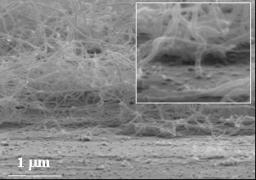


Multi-layered carpets obtained through a sequential synthesis procedure and showing that any new layer is growing on the substrate under the pre-existing ones by lifting them up. (a) SEM image of a sample synthesised from 5 injection sequences of toluene/ferrocene aerosol ; the duration of the first two sequences are doubled as compared to the last three sequences ; (b) left : SEM image of a sample synthesised from two injection sequence of benzene/ferrocene aerosol, the second sequence contains 13C isotope labels ; right : mapping obtained with nuclear microprobe and showing the diffusion of C through the whole carpet already formed. [M. Pinault, Nano. Lett 2005]
•  Materials for new energy technologies › Nanostructured materials for energy
Materials for new energy technologies › Nanostructured materials for energy  Synthèse et caractérisation des nano-objets / Synthesis and characterization of nano-objects › Nanostructured materials and nanocomposites
Synthèse et caractérisation des nano-objets / Synthesis and characterization of nano-objects › Nanostructured materials and nanocomposites











